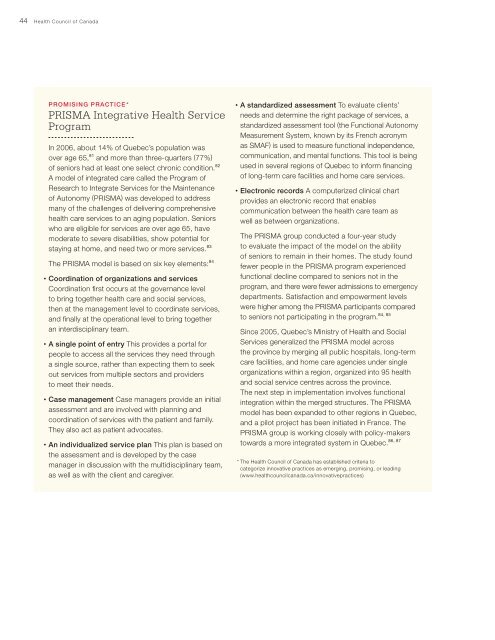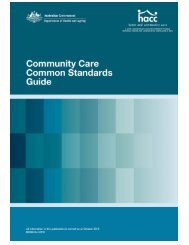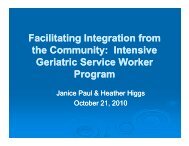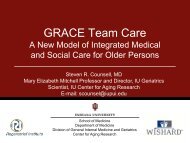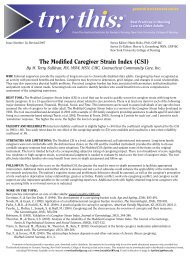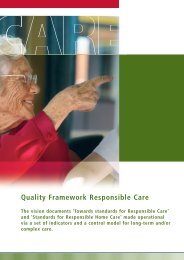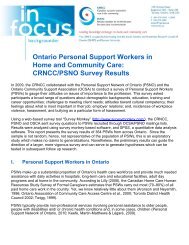Seniors in need, caregivers in distress:
Seniors in need, caregivers in distress:
Seniors in need, caregivers in distress:
You also want an ePaper? Increase the reach of your titles
YUMPU automatically turns print PDFs into web optimized ePapers that Google loves.
44 Health Council of Canada<br />
PROMISING PRACTICE *<br />
PRISMA Integrative Health Service<br />
Program<br />
In 2006, about 14% of Quebec’s population was<br />
over age 65, 81 and more than three-quarters (77%)<br />
of seniors had at least one select chronic condition. 82<br />
A model of <strong>in</strong>tegrated care called the Program of<br />
Research to Integrate Services for the Ma<strong>in</strong>tenance<br />
of Autonomy (PRISMA) was developed to address<br />
many of the challenges of deliver<strong>in</strong>g comprehensive<br />
health care services to an ag<strong>in</strong>g population. <strong>Seniors</strong><br />
who are eligible for services are over age 65, have<br />
moderate to severe disabilities, show potential for<br />
stay<strong>in</strong>g at home, and <strong>need</strong> two or more services. 83<br />
The PRISMA model is based on six key elements: 84<br />
• Coord<strong>in</strong>ation of organizations and services<br />
Coord<strong>in</strong>ation first occurs at the governance level<br />
to br<strong>in</strong>g together health care and social services,<br />
then at the management level to coord<strong>in</strong>ate services,<br />
and f<strong>in</strong>ally at the operational level to br<strong>in</strong>g together<br />
an <strong>in</strong>terdiscipl<strong>in</strong>ary team.<br />
• A s<strong>in</strong>gle po<strong>in</strong>t of entry This provides a portal for<br />
people to access all the services they <strong>need</strong> through<br />
a s<strong>in</strong>gle source, rather than expect<strong>in</strong>g them to seek<br />
out services from multiple sectors and providers<br />
to meet their <strong>need</strong>s.<br />
• Case management Case managers provide an <strong>in</strong>itial<br />
assessment and are <strong>in</strong>volved with plann<strong>in</strong>g and<br />
coord<strong>in</strong>ation of services with the patient and family.<br />
They also act as patient advocates.<br />
• An <strong>in</strong>dividualized service plan This plan is based on<br />
the assessment and is developed by the case<br />
manager <strong>in</strong> discussion with the multidiscipl<strong>in</strong>ary team,<br />
as well as with the client and caregiver.<br />
• A standardized assessment To evaluate clients’<br />
<strong>need</strong>s and determ<strong>in</strong>e the right package of services, a<br />
standardized assessment tool (the Functional Autonomy<br />
Measurement System, known by its French acronym<br />
as SMAF) is used to measure functional <strong>in</strong>dependence,<br />
communication, and mental functions. This tool is be<strong>in</strong>g<br />
used <strong>in</strong> several regions of Quebec to <strong>in</strong>form f<strong>in</strong>anc<strong>in</strong>g<br />
of long-term care facilities and home care services.<br />
• Electronic records A computerized cl<strong>in</strong>ical chart<br />
provides an electronic record that enables<br />
communication between the health care team as<br />
well as between organizations.<br />
The PRISMA group conducted a four-year study<br />
to evaluate the impact of the model on the ability<br />
of seniors to rema<strong>in</strong> <strong>in</strong> their homes. The study found<br />
fewer people <strong>in</strong> the PRISMA program experienced<br />
functional decl<strong>in</strong>e compared to seniors not <strong>in</strong> the<br />
program, and there were fewer admissions to emergency<br />
departments. Satisfaction and empowerment levels<br />
were higher among the PRISMA participants compared<br />
84, 85<br />
to seniors not participat<strong>in</strong>g <strong>in</strong> the program.<br />
S<strong>in</strong>ce 2005, Quebec’s M<strong>in</strong>istry of Health and Social<br />
Services generalized the PRISMA model across<br />
the prov<strong>in</strong>ce by merg<strong>in</strong>g all public hospitals, long-term<br />
care facilities, and home care agencies under s<strong>in</strong>gle<br />
organizations with<strong>in</strong> a region, organized <strong>in</strong>to 95 health<br />
and social service centres across the prov<strong>in</strong>ce.<br />
The next step <strong>in</strong> implementation <strong>in</strong>volves functional<br />
<strong>in</strong>tegration with<strong>in</strong> the merged structures. The PRISMA<br />
model has been expanded to other regions <strong>in</strong> Quebec,<br />
and a pilot project has been <strong>in</strong>itiated <strong>in</strong> France. The<br />
PRISMA group is work<strong>in</strong>g closely with policy-makers<br />
86, 87<br />
towards a more <strong>in</strong>tegrated system <strong>in</strong> Quebec.<br />
* The Health Council of Canada has established criteria to<br />
categorize <strong>in</strong>novative practices as emerg<strong>in</strong>g, promis<strong>in</strong>g, or lead<strong>in</strong>g<br />
(www.healthcouncilcanada.ca/<strong>in</strong>novativepractices)


